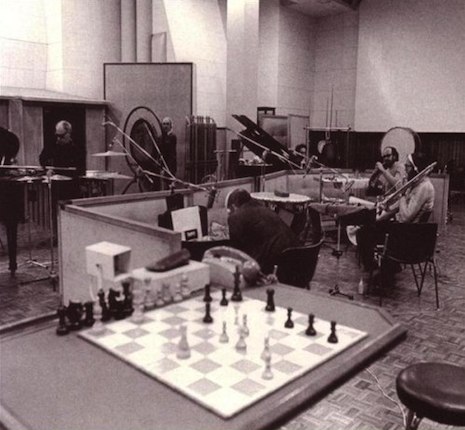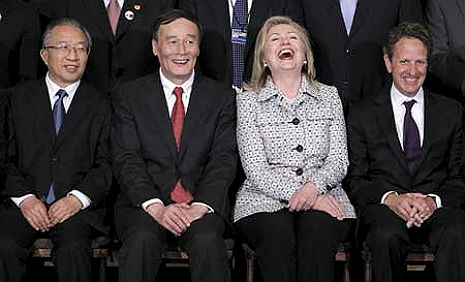
If you’re out of loop on the whole HANKSY graffiti thing popping up on the streets of NYC, here’s the first HANKSY that appeared about a month ago.
(via Wooster Collective)

If you’re out of loop on the whole HANKSY graffiti thing popping up on the streets of NYC, here’s the first HANKSY that appeared about a month ago.
(via Wooster Collective)

According to the YouTube comments this genre of music is called Drumstep, not Dubstep. It’s hard to keep track these days.
(via Nerdcore)

This is a guest post by writer and musician Dave Madden. Take it, Dave:
What lingers in the closets of the Brass Ring of recent film composers? James Horner scored Robert Conrad’s kinda-crappy cult classic The Lady in Red. James Newton Howard did session work for Ringo and arranged songs for Olivia Newton-John. And then you have Ennio Morricone whose wardrobe contains enough oddity to match the awards on his mantle.
During the mid ‘60s, while Morricone was securing his role as the Spaghetti Western king via Sergio Leone’s Dollars trilogy, he became a member of Gruppo di Improvvisazione di Nuova Consonanza, a revolving collective of musicians dedicated to “anti-musical systems and noise techniques” (note: he was part of the band even throughout his days with Dario Argento and his first academy award nomination for the 1979 Days of Heaven).
GDIDNC loosely labeled their technique “Instant Composition”, as everything went direct to tape, not staff paper. They merged a collage of the previous 50 years – Webern-like serialistic pointillism, free jazz, spectralism, Musique concrète – with extra-musical philosophies and disciplines; not to be confused with aleatoricism, they crafted their works not by emptying their preconceptions to get to zero, but incorporating myriad ideas and exercises to guide themselves to zero. While that reads as par for the course for improvising musicians today, there are a few things that separate them from your average non-musician – and placed the crew in the flagship ranks of AMM and Musica Elettronica Viva, and turned them into idols for a young John Zorn (he wrote the liner notes to their 2006 box set, Azioni) .
First, each of the tenuous group was a fantastic musician, respected sound artist and/or scientist: a friend and collaborator of Karlheinz Stockhausen and Luigi Nono (who, together, established the Experimental Studio of the Polish Radio in Warsaw), Gruppo founder and pianist Franco Evangelisti was involved with the Studio of Experimental Electroacoustics of UNESCO, focusing on the biophysics of brain impulses as sonic vibrations; Mario Bertoncini (percussion, piano) made his living as a music educator and, for decades, a concert pianist; Roland Kayn’s (Hammond organ, vibraphone, marimba) “monumental graphic scores” for orchestra were performed by Pierre Boulez, though he later devoted his life to “Cybernetic Music”, a sonic renewing process that became the focus of his ten-hour long Scanning. And so on with all eighteen-and-counting purported contributors.
More importantly, as former Down Beat editor Art Lange points out, they were all known for their compositional savvy:
The key words here, however, are “composers” and “organized.” Evangelisti insisted on a performing ensemble that consisted solely of composers in part because of the inherent (even if intuitive) sense of formal logic they would bring to the performance, but also to avoid any taint of instrumental virtuosity for its own sake.
Lastly, when they performed, the disparate personalities combined into a single, flailing behemoth that did not understand the concept of “lull” or “wandering” as it pursued its artistic objective.
Observe part of “Strings Quartet”:
Wait for the percussive bombast near 7:20
Morricone after the jump…

Why are these people smiling? Fom left, Chinese Vice Premier Wang Qishan, Chinese State Councilor Dai Bingguo, Hillary Clinton, and U.S. Secretary of the Treasury Timothy Geithner at the 2011 U.S.-China Strategic and Economic Dialogue at the U.S. Department of State in Washington, D.C., Monday, May 9.
A guest editorial courtesy of our super smart friend, Charles Hugh Smith, cross-posted from his essential Of Two Minds blog:
In a classic Marxist set-up, Capital is free to exploit labor because labor is in surplus.
The fundamental dynamics of the U.S.-China trade partnership—certainly the biggest economic story of this generation—boil down to “capital exploits labor.” I am well aware that this sort of quasi-Marxist analysis is supposed to be passe in the era where young nerds can start billion-dollar enterprises in a garage or dorm room. Capitalism is a priori “win-win,” as all those workers in China are getting ahead while our youth launch $50 million IPOs of social networking Web 2.0 companies.
But if you scrape away the high-gloss propaganda and myth-making, then the fundamental dynamic is definitely Marxist: American capital jettisoned American labor as a costly hassle in favor of cheap, no-hassle Chinese labor.
Since Capital’s best buddy in the whole world is the Central State and its proxies, i.e. the Federal Reserve, then the Central State and the central bank (the Fed) smoothed over the exploitation and furthered the consumer economy by inflating a credit-housing bubble. Since 60% of American households own a home, this enabled the increasingly impoverished “middle class” to borrow trillions of dollars in “free” money that could be spent—surprise!—on the new imports from China that filled the shelves of big box global retailers everywhere.
Allow me to illustrate this dynamic by deconstructing two recent stories in the Mainstream Financial Media: ‘Superjobs’: Why You Work More, Enjoy It Less Businesses expect a lot more out of their employees these days…
Taco Bell and the Golden Age of Drive-Thru: Operational innovations at restaurants like Taco Bell rival those at any factory in the world.
The first piece describes in clinical fashion how U.S. capital is ruthlessly exploiting labor, demanding more work for little to no additional pay. The underlying dynamic here is purely Marxist: capital encourages over-supply of labor, which then drives the value of labor down. Competition for the few jobs available makes desperate wage-earners willing to put up with exploitation and insecurity because the options of escaping the cycle of centralized Corporate value extraction are insecure and risky.
Global Corporate America fosters a surplus of labor in the U.S. via three mechanisms:
1. Vast illegal immigration which keeps labor costs down in low-skill corporate workhouses such as slaughterhouses, fast-food outlets, etc.
2. H1-B visas for high-tech workers (now falling out of favor as those positions are better filled directly in India and China).
3. Ship production, software coding and back-office functions to China, and to a lesser degree, to India and elsewhere in east Asia.
The unemployment rate among PhDs is roughly 50%. So much for “winning” by becoming ever more educated. The number of slots in academia is shrinking, and the total number of research positions is relatively inelastic. For more on academia’s “plantation economy,” please read Faulty Towers: The Crisis in Higher Education (The Nation).
With labor in surplus, capital is free to demand whatever it needs to boost all-important profits. The propaganda machines in HR (human resources) spray-paint slogans everywhere (“you’re really really valuable to us, Super-Duper Team Member!”) but everyone knows the reality: everybody is dispensible, and everyone but the CIO at a hot startup a few months from an IPO is a corporate serf a paycheck away from being booted out of the castle into abject poverty.
As a result of this exploitation—known as “wage abritrage”—corporate profits (which boost the wealth of the top 10% who owns the vast majority of stocks and mutual funds) are extremely plump and juicy:

In the second piece, BusinessWeek breathlessly assures us that we have thousands of highly efficient factories running 24/7 in the U.S.—fast food outlets. Yes, all 6,000 Taco Bells are miniature factories pumping out “product” in vast quantities. The fast food “industry” revenues are $168 billion a year, and the workers, we’re told, are paid $1.25 above minimum wage—woo-hoo, love you, Corporate America!—which means that the full-time employee makes $16,500 a year.
$16K a year doesn’t go very far in urban America, but there is no pressure on Corporate America to raise wages.
I realize that I am an outsider, and biased against global corporate power regardless of the nominal country of origin (down with Canal+!), but I still found it noteworthy that BusinessWeek could run thousands of words of glowing praise for the profitable efficiency of the fast food “industry” without noting that it isn’t an industry at all—it’s just a consumerist fantasy (fast and cheap meals that require no effort or discipline) that produces “food” of low value that pushes the consumer into ill-health with overloads of salt, sugar, and low-grade fat.
70% of the fast “food” served is via the drive-through window, which suggests that an overworked, stressed out, focused on getting through the next two hours American is opting to shut the kids up and stave off hunger by pulling into the drive-through lane and loading up on a “meal” that they know is bad for them but they have no time to make a real meal at home (or so they’ve been brainwashed by thousands of hours of adverts).
If Taco Bell is the “manufacturer/factory of the New America,” then I think we need a peaceful revolution, and soon. The toadies and sycophants of the financial media are pleased to worship 1) CEOs 2) profits 3) efficiencies 4) globalized “growth” as long as its owned by global corporations and of course, everyone’s favorite, 5) innovation, because “innovation” drives profits!
Elsewhere in the latest issue, BusinessWeek breathlessly cooed over digital game company Electronic Arts latest “innovation,” which was selling a digital parrot for $10 a pop that sits on your digital warrior’s shoulder.
Excuse me while I raise my glass to American “innovation.” If pumping out fast food garbage (hello, 60% obesity rates, is there any connection?) is the new American “factory” and “innovation” is selling kids with access to Mom’s credit card a $10 digital parrot (and what does the parrot say? “Kill ‘em all and let God sort ‘em out, brawk!”) for their hyper-violent fantasy wargame, then this nation is well and truly doomed.
To reap a fat profit, you need to sell the stuff being imported from the American-owned factories in China. Since wages have been flat for decades, that posed a problem, as consumers were tapped out. Never fear, capital’s best buddy rode to the rescue, inflating a stupendous credit-housing bubble that enabled the working stiff to speculate “like the big boys” with free money and limitless leverage, all supported by lies (liar loans) and the misrepresentation of risk.
Wall Street reaped tens of billions in profits originating and packaging the debt loaded onto the middle class debt donkeys—not just mortgages, but auto loans, student loans and even credit card debt.
But now, at long last, capital’s doting partner, the Federal Reserve, has run into a spot of bother: the only way to keep profits rising is to crash the dollar, and doing that has squeezed the purchasing power of the debt donkeys. By exporting inflation to China and the rest of the world, the Fed has engineered massive profits for U.S. corporations (when profits earned overseas are stated in dollars, presto, a 10% increase) but it has also forced China into raising prices and fueled an oil and import-driven inflation in the U.S. which has caused millions of insolvent households living paycheck to paycheck to cut back on their consumption.
China has its own problems, namely runaway domestic inflation (thanks, Federal Reserve) and finding places to dump its excess dollars. It was a wonderfully beneficial trade for awhile: we print paper money, and you give us tangible goods for the paper. Thank you very much, and we can offer you some terrific low-yield Treasuries to recycle your growing stash of dollars.
The Fed’s inflation games are sinking the value of the dollar, and the Chinese are not amused. They are trying to buy tangible resources with their ocean of depreciating dollars, and even sinking to buying Spanish debt.
They have another problem: as capital’s return in China slips, it will exit China just as fast as it exited the U.S.
There is a grand irony in that dynamic: a supposedly Communist country trying to run a central-command quasi-capitalist economy will find that Marx had a point after all. Not that the leadership is at risk themselves; the ChiCom offspring already have homes in Vancouver B.C. and Los Angeles and citizenship/green cards, and the family fortune is safely invested in Switzerland and North America.
The “story” is that the Chinese consumer is about to step up spending, and as a result, “you gotta be in China to profit from all the trillions in new consumer spending.” The reality is that the Chinese middle class is already spending like drunken sailors and their 900 million rural compatriots already own TVs and other cheap consumer goods.
The reality is that Capital has already skimmed the big, fat easy profits, and it’s looking elsewhere as labor costs and pesky regulations rise in China. The truth is American and European corporations have already earned out their investments in China, and shipping the factories from China to Vietnam is not much different than crating the factory up in the U.S. and shipping it to China.
There is a theory that the Fed’s “master plan” is to sink the dollar to the point that the low-income states in the U.S. will be the lowest-cost manufacturing base in the world.
At $16,500 a year for full-time workers pushed to maximum production, they might be getting close.
The above essay was written by Charles Hugh Smith and is cross-posted from Of Two Minds

I’m freaking out over how insanely BAD this is (not bad meaning good but bad meaning terrible). Seriously folks, I need help, I mean is this FOR REAL?! First up I can’t stop giggling, but secondly it raises a lot of questions. “Why?!” being one, closely followed by “Maybe she’s mad because he wrote this sucky song about her?” And who the hell is “Mayberry”?
Well, at least one thing is for sure - this gives lie to the myth that “making music is easy with Autotune.” Kind of. I’ve messed around with Autotune before (if you own a Mac you have a cheap version as part of Garageband) and know that these guys have to be doing something really wrong for it to sound this bad. In all fairness though, this was uploaded over two years ago. Maybe PtheG has improved since then?
PtheG - “She’s Mad”
Oh the humanity.

Boyle and Smith at Bell Labs.
The co-inventor of the charge-coupled device, CCD, Willard S. Boyle has died. His invention altered the way we capture and share images forever. What you see is what you get, thanks to Boyle and his partner George E. Smith.
The CCD is a device that is smaller than a dime and…
[...] is the eye behind every picture on the Internet, every digital and video camera, every computer scanner, copier machine and high-definition television.
Its work extends from supermarket barcode readers to the Hubble Space Telescope, from fax machines to the cameras that roamed Mars and the oceans’ floor.
It works by taking advantage of what is called the photoelectric effect, which was explained by Einstein and brought him the Nobel in 1921. The photoelectric effect is the name given to the observation that when light is shined onto a piece of metal, a small current flows through the metal.
The CCD devised by Dr. Boyle and George E. Smith captures light and stores it, then displays it by converting it into electrical charges.
In this video from 1978, Boyle and Smith describe how their invention, for which they were awarded the Nobel Prize in 2009, functions.

Sonic Youth perform fiery versions of “Mary Christ” and “The Bedroom” in the parking lot of the San Franciso Tower Records in 1991. Video shot by Matt Cornell.

I mean, come on, honestly, is there any other way to interpret the news that over half of all Republicans are STILL unsure—if not hostile to the idea—that President Obama was born in the United States? That’s right, a new poll out today from Public Policy Polling (which is a Democratic polling firm) found that an incredible THIRTY FOUR percent of Republicans still believe that Obama was not born on domestic soil. Another 18 percent didn’t know where he was born or were unsure.
This is some stupid, stupid, low IQ shit going on here.
And this is the Republican BASE. Over half of ‘em! Who can argue with that?
My easy to reach, rather unavoidable conclusion: More than half of the Republican party are fucking idiots.
From Slate:
Those numbers are a far cry from the percent who questioned where Obama was born before the White House released his long-form birth certificate last month.
Still, when those who answered the question, “Do you think Barack Obama was born in the United States?” with either a “No” or a “Not Sure” are taken together they represent more than half of those surveyed and, obviously, make up a formidable bloc of primary voters that can’t be discounted in a wide-open GOP primary contest.
Mitt Romney looks to be the candidate most likely to be hurt by the persistent “birther” faction. He placed second in the PPP poll with 18 percent, trailing Mike Huckabee by one point. But if you remove those who remain unconvinced that Obama was born in the U.S., Romney leads Huckabee and the rest of the field with 22 percent. (Huckabee remains at 19 percent.)
It’s…ah… telling which of the current crop of GOP midgets presidential hopefuls circling around the early primary states these flatearthers afterbirthers support:
Meanwhile, the candidates who appear to be benefitting most from the remaining birthers are Sarah Palin, Newt Gingrich, Michele Bachman and, ever so slightly, Donald Trump. All of those candidates fare better among those who answered “No” than they do overall with GOP voters.
Palin support moves up from 12 percent to 17 percent, Michele Bachman support increases three points to 10 percent, Gingrich climbs two points to 15 percent and Donald Trump inches up from 8 percent to 9 percent.

Once again, it’s the Eurovision Song Contest - that annual shindig where people who should know better represent their country in a live televised song competition. Even if you haven’t heard of Eurovision, you’re bound to have heard some of the past winners, such as: Abba with “Waterloo”, Teach-In with “Ding-a-Dong”, Lulu with “Boom-Bang-a-Bang”, France Gall with “Poupée de cire, poupée de son”, Dana International with “Diva”, Bucks Fizz “Making Your Mind Up” and Johnny Logan, with..well, Johnny’s your actual Mr Eurovision, having won the competition on three separate occasions.
This year the Eurovision has been slightly overshadowed by the (near) bankruptcy of certain Euro-zone countries and their bail out. This financial melt-down has inspired Portugal to select Homens Da Luta with their rousing radical ditty, “The Struggle Is Joy”, as their offiiclal entry into the competition.
The band have come up with “a politics-packed staging of their routine” which, as the Wall Street Journal reports, includes:
...red-and-green lighting to commemorate the country’s 1974 revolution, outfits symbolizing Portugal’s history (which, apparently, shares a lot with that of the Village People), and lyrics that tackle the Lusophone nation’s parlous economic state:
There’s no point in tightening the belt
There’s no point in complaining
There’s no point in frowning
And rage is pointless, it won’t help youIndeed, the €78 billion ($115.69 billion) financial bailout the country agreed with the IMF and EU last week will likely cause the Portuguese economy to contract by around 2% in 2011 and 2012, meaning that Homens Da Luta can’t afford to do too well when it comes to the voting, as hosting the competition next year — the winner’s honor — would likely add to the country’s budget problems.
Many people advise you to watch out
Many people wish to silence you
Many people want you to feel resentful
Many people want to sell you the air itselfThis, surely, is a thinly-veiled reference to the multiple downgrades suffered by the country recently and IMF Chief Dominique Strauss-Kahn saying the package will require a “sacrifice” by the Portuguese people.
Moreover, just as some question the compatibility of the EU bailout package with the bloc’s treaties, Homens Da Luta, are being purposely vague with their lyrics in order to stay on the right side of Section 4, Rule 9 of the Eurovision Song Contest, which, just to recap, states that “No lyrics, speeches, gestures of a political or similar nature shall be permitted during the Eurovision Song Contest.”
This kind of specific political message is what saw Georgia’s 2009 entry excluded on the grounds of it’s Putin-baiting lyrics, bringing an unprecedented convergence to geopolitical tension in the former Soviet bloc and magenta sequin disco hot pants. According to Homens Da Luta, though, the message is more of a generalist call to feel good about Portugal.
“Our song doesn’t speak badly of Germany or any other country,” lyricist Jel told the BBC. “We go to Germany to show Europe that Portuguese people are not sad people. We are happy people who want to live with all our brothers in Europe.”
Portugal’s Homens Da Luta sing ‘The Struggle Is Joy’, after the jump…
With thanks to Ewan Morrison

Sixty four dancing “tree” magnets covered in iron dust are synchronized to Bronski Beat’s “Smalltown Boy” by artist David Durlach of TechnoFrolics. Even if you’re not a fan of poppy 80s hi-NRG disco, you can’t help but find this video utterly hypnotic.
(via Cakehead)